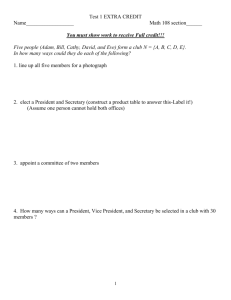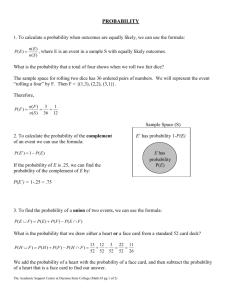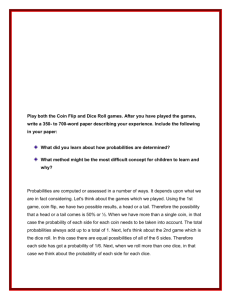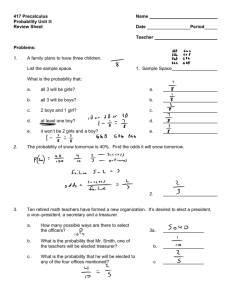section 4.5
advertisement
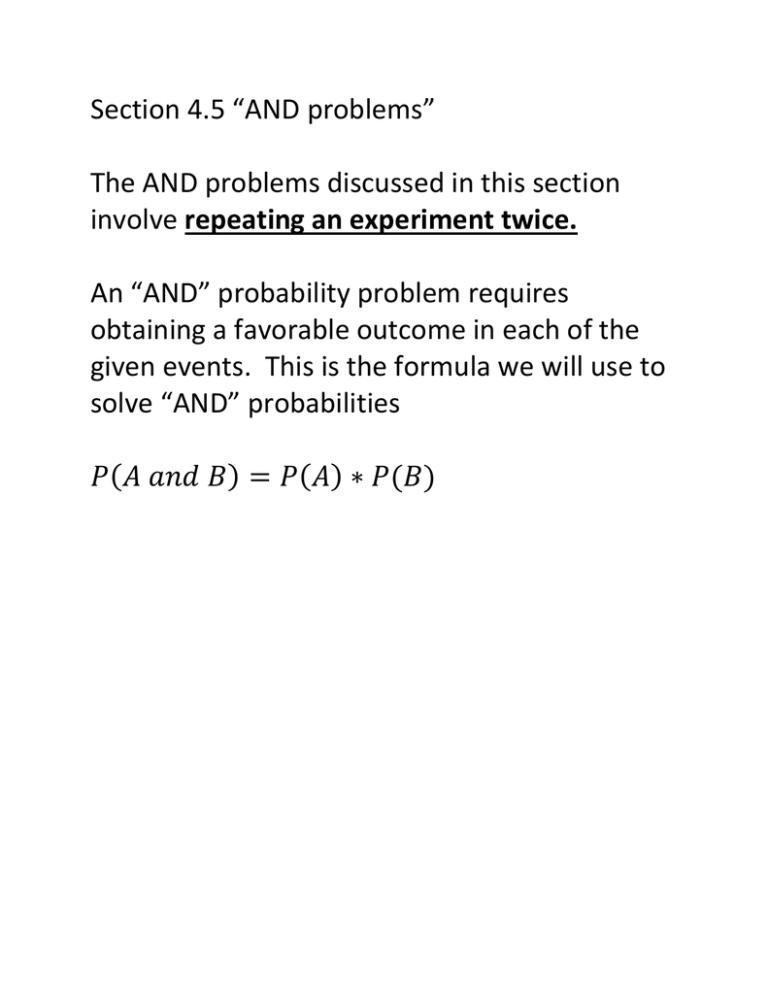
Section 4.5 “AND problems” The AND problems discussed in this section involve repeating an experiment twice. An “AND” probability problem requires obtaining a favorable outcome in each of the given events. This is the formula we will use to solve “AND” probabilities 𝑃(𝐴 𝑎𝑛𝑑 𝐵) = 𝑃(𝐴) ∗ 𝑃(𝐵) Example: Two cards are selected with replacement from a standard deck of cards. Determine the probability that two queens will be selected. We consider this an “AND” problem as we need to get a queen on the first selection AND on the second selection. I need to be able to compute two probabilities to answer this question. P(queen 1st) = 4/52 as there are 4 queens in a deck of 52 cards P(queen 2nd) = 4/52 since this is a with replacement problem there are still 4 queens of the 52 cards that can be selected. P 2 queens P queen1 P queen2 Answer: 1/169 4 52 × 4 52 = 1 169 = .59% Example: Two cards are selected without replacement from a standard deck of cards. Determine the probability that two queens will be selected. I need to be able to compute two probabilities to answer this question. P(queen 1st) = 4/52 as there are 4 queens in a deck of 52 cards P(queen 2nd) = 3/51 This is a without replacement problem only 3 queens left as one of them has been selected already. There are only 51 cards left as the queen that was selected first is no longer in the deck P 2 queens P queen1 P queen2 4 52 3 1 × = = .45% 51 221 Answer: 1/221 Definition: Event A and Event B are called independent events if the occurrence of either event in no way affects the probability of occurrence of the other event. Rolling a die and tossing a coin are examples of independent events. This is because if a coin comes up heads or tails it won’t affect the number that comes up on a dice. It’s a little trickier to determine if events are independent with the card scenario we just covered. In our 2 Queens example (the first one WITH replacement) is an example of an INDEPENDENT events problem as the probability of getting a queen on the second selection did not change do to the first selection. BUT the second 2 Queens example (the one WITHOUT replacement) is an example of a DEPENDENT events problem because the probability of selecting the second queen was affected by removing the first queen selected form the deck. Homework # 1 – 10: Two cards are selected at random from a deck of 52 cards WITHOUT replacement. Find the requested probabilities, (write your answer as a reduced fraction.) 1) Both cards are red 2) Both cards are black 3) The first card is a 7 and the second card is a 4 4) The first card is a queen and the second card is a 3 5) Both cards are fives 6) Both cards are face cards 7) The first card is red and the second card is black 8) The first card is a heart and the second card is a spade 9) The first card is not a seven and the second card is a seven 10) The first card is not a four and the second card is a four Homework # 11 – 20: Two cards are selected at random from a deck of 52 cards WITH replacement. Find the requested probabilities (write your answer as a reduced fraction) 11) Both cards are hearts 12) Both cards are spades 13) The first card is a six and the second card is black 14) The first card is black and the second card is a six 15) The first card is a face card and the second card is not a face card 16) Both cards are face cards 17) Neither card is black 18) Neither card is a spade 19) The first card is a queen and the second card is a seven 20) The first card is not a queen and the second card is not a seven Homework # 21-24: The spinner below is spun twice, find the requested probabilities (write your answer as a reduced fraction.) 21) Both spins are yellow 22) Both spins are purple 23) The first spin is green and the second is not red 24) The first spin is not yellow and the second spin is red Homework # 25-28: The spinner below is spun three times, find the requested probabilities (write your answer as a reduced fraction.) 25) The spins in order are green, yellow the blue 26) The spins in order are green, green and yellow 27) Green is spun each time 28) Yellow is spun each time Homework #29 – 32: A coin is tossed then a dice is rolled, find the requested probabilities (write your answer as a reduced fraction.) 29) The coin is a head and the dice is a 4 30) The coin is a tail and the dice is not a 4 31) The coin is not a head and the dice is an even number 32) The coin is not a tail and the dice is greater than 2 Homework #33-34: A sample of 30 women who recently had a home built yielded the following information about their builder: Number of women 19 6 5 Would you recommend builder to a friend Yes No Not sure Three women who provided information for the table were selected at random. Find the probability that: 33) The first would not recommend her home builder, but the second and third would recommend their home builder. 34) The first would recommend her home builder, but the second and third would not recommend their home builder. Homework #35-38 Two marbles are drawn from a bag that contains 5 blue, 3 red and 2 purple marbles without replacement. Find the requested probabilities 35) Both are blue 36) Both are red 37) The first is purple and the second is not blue 38) The first is purple and the second is red Homework #39-42 Two marbles are drawn from a bag that contains 5 blue, 3 red and 2 purple marbles with replacement. Find the requested probabilities 39) Both are blue 40) Both are red 41) The first is purple and the second is not blue 42) The first is not purple and the second is red Answers, with a bit of work: 1) 26 52 11) 21) 29) 39) 25 25 ∗ 51 = 102 3) 13 13 4 1 5 1 2 1 1 ∗ 5 = 25 1 1 ∗ 6 = 12 5 10 5 31) 1 ∗ 10 = 4 5 1 2 41) 4 26 1 4 4 ∗ 5 = 25 25) 3 1 ∗6=4 2 10 5 33) 1 ∗ 10 = 10 3 1 2 1 ∗ 51 = 221 7) 52 ∗ = 26 15) 52 52 1 23) 4 ∗ 51 = 663 5) 4 ∗ = 16 13) 52 52 1 4 52 4 40 1 6 52 10 ∗ = 169 17) 52 52 1 1 13 26 26 ∗ 29 ∗ 28 = 2030 35) 10 19 18 171 2 1 48 52 ∗ = 4 19) 52 52 1 27) 1 26 ∗ 51 = 51 9) 1 ∗ 4 ∗ 4 = 32 30 26 4 16 ∗ 51 = 221 4 4 1 ∗ = 169 52 52 1 ∗2∗2=8 5 4 2 ∗ 9 = 9 37) 2 10 4 4 ∗ 9 = 45
